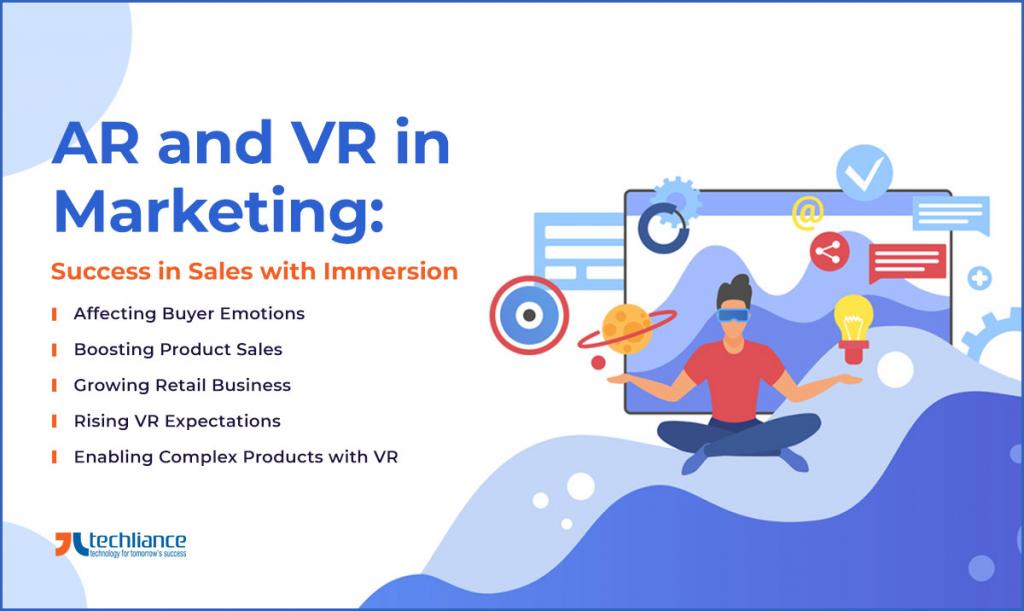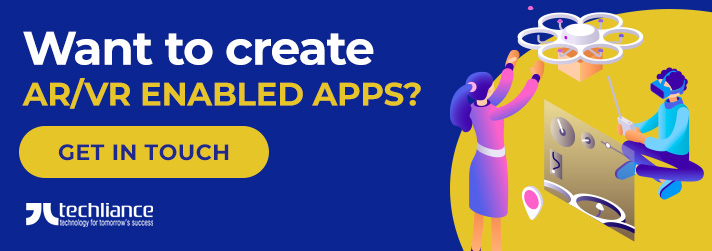Augmented and virtual reality both have opened up new horizons for marketing. With their help, businesses can get a lot of impressions for a new product or service. AR and VR in marketing are prime examples of how creative and non-standard solutions attract the target audience.
The experience gained through trying something new is always remembered much better. What is the phenomenon of technology (and especially immersive technology)? That until recently was associated by most with attractions and science fiction.
Companies appreciate the experience of experts whose task is to develop mobile apps that include VR & AR technologies. Where previously their inventions were educational and entertaining, they are now a powerful marketing tool. The trend was picked up by representatives of the owners of famous brands.
Usage of immersive technology is a great opportunity to approach the solution of strategic tasks. Similarly, AR and VR in marketing are empowering the fields of branding, advertising, and PR from a new perspective.
The development of augmented reality for business opens up a lot of opportunities for creative marketers. They were previously forced to abandon some ideas due to limited resources. Advertising concepts that are difficult to realize in a photo or video format, are successfully implemented using AR and VR.

What’s new in Virtual Reality?
By 2020, two important stages in the evolution of the VR industry have taken place. First, the “unbinding” of devices from the computer, with which they were previously connected with a powerful wire. Second, the supply of devices with space controllers allows them to avoid bumping into real objects in the virtual world.
However, 2019 had brought more than just new items. In October 2019, Google announced to shut down the Daydream project, a VR hardware that works with Android phones. This led to the termination of daydream projects by BBC, HBO, and Hulu, etc.
AR and VR in Marketing: Success in Sales with Immersion
Usage of AR and VR in marketing leads to success in sales, thanks to immersion. These are some use cases where it is already happening.
- Affecting Buyer Emotions
- Boosting Product Sales
- Growing Retail Business
- Rising VR Expectations
- Enabling Complex Products with VR
Now, we discuss these use cases of AR and VR in marketing in detail.
Affecting Buyer Emotions
When a person first encounters a new, interesting technology for him, a wow effect arises. Customers unconsciously focus on a product or service; they want to try.
The impressions of a novelty presented unusually are always brighter. And the opportunity to experience emotions before buying only strengthens the desire to make it. Tasting works the same way.
Boosting Product Sales
The development of augmented reality in the form of an application for a smartphone or tablet is the most common. Because almost every customer can use such a program. It is enough to download it to a device that supports this technology.
A frequent occurrence is the creation of applications in which children can interact with their favorite characters. Programs with the possibility of trying on are no less popular. Let’s say, after downloading the application, the user can “put on” fashionable glasses or simulate a haircut.
When developing virtual reality for marketing purposes, the emphasis is on the immersive experience. For instance, the opportunity to view a home that is offered to be purchased with a mortgage. This is a decisive factor for many clients before buying.
Growing Retail Business
Talking of 2021, virtual and augmented realities are interesting marketing and advertising tools. It is augmented reality that is more popular in retail. Customers like to try on the assortment of the store or evaluate how furniture will look in the interior.
It was AR that caused the boom in eyewear websites. Before that, very few people thought of ordering through the Internet at random what you wear later, without taking off. So, simple and useful visualization functions started the way in marketing.
Watching regular TV ads attracts a consumer for a paltry two and a half seconds. Augmented reality, on average, takes over us 73 seconds longer. According to Goldman Sachs, the retail VR and AR market will reach $ 1.6 billion by 2025.
There is a VR store in Australia – the famous Australian departmental store MYER. Together with eBay, it has created an application that allows customers to make purchases in virtual reality.
The auto giants quickly recognized the benefits of VR. Why invite customers to the salon when the car can be viewed in virtual reality? Volvo started exactly with test drives in 2014, using Google Cardboard for this.
The experience turned out to be successful, then a project using Microsoft Hololens followed in 2015. And in 2018, Volvo launched a VR project that allows users to experience different driving situations. This time the HTC Vivo VR kit became the base one.
Moreover, it enables customers to see the benefits of Volvo’s safety systems. These three cases allow us to assess how rapidly the quality of the VR environment has improved in few years.

Rising VR Expectations
Sony plans to launch the PlayStation 5, which will drive demand for VR kits that are compatible with the console. Panasonic also promised to please with the novelty – the world’s first VR glasses with Ultra HD resolution.
Nvidia and Intel are two half-shadow players of virtual reality, manufacturers of processors, and video cards that support immersive graphics. They presented developments at the exhibitions that later on entered the market in 2020. By the way, Intel has occupied an interesting niche of sports broadcasts in VR format.
Enabling Complex Products with VR
Sometimes the product itself is complex and intangible. For example, insurance services. It is difficult for a customer to get an idea from texts and video materials. Instead, a lively and immersive VR experience can quickly motivate a potential buyer.
Insurance companies were among the first to realize the benefits of VR. The American Liberty Mutual shot a whole series of VR videos with useful advice for all occasions. Of course, it very convincingly proves that you need insurance.
An outside person can’t get to factories or data centers of IT giants. But a VR tour allows you to assess the scale and respect the companies. A good example is the classic VR tour to the European Toyota car plant. Another example is the technical and PR-excellent tour to the Google data center.
Immersive technologies blur boundaries. What seemed fantastic before is already in every helmet. We follow the progress of techno evolution and enjoy new opportunities.

Conclusion
Do you need to build AR/VR-powered apps or website solutions? Skilled experts at Techliance can help you in embracing immersive technology. Connect with us to start your future-focused transformation journey now.




